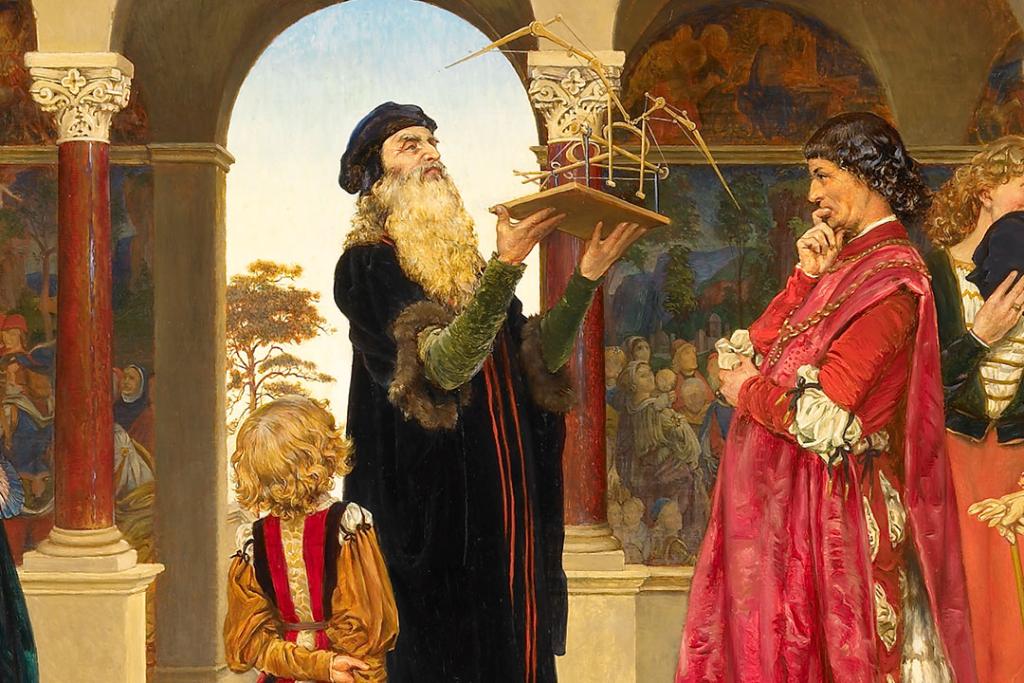
The Forerunner - Leonardo da Vinci

The famous artist and scientist Leonardo da Vinci (born in 1452, died in 1519) is showing a model of his flying machine to his patrons, Ludovico Sforza and Beatrice d'Este. Sforza is the figure to the right of Leonardo. He was the Duke of Milan between 1494 and 1499. The painting reflects the difficult relationship Leonardo had with his patrons. Sforza was often late in paying Leonardo or cancelled his projects at short notice.

The Forerunner, Eleanor Fortescue-Brickdale, 1920
Brickdale's interest in the subject reflects her enthusiasm for Renaissance art. The model seems to be based on a drawing in Leonardo’s Codex MSSB (book of scientific drawings now in the Institut de France) thought to date from the late 1480s. She may have also been inspired by her personal connections with Charles Rolls, the aviator, and her own interest in aeroplane technology. There was widespread interest in Leonardo's work on flight during the early 1920s, when this painting was first exhibited.
This painting is also interesting because it incidentally brings together two important figures from the history of homosexuality; Girolamo Savonarola (born in 1452, died in 1498) and Leonardo da Vinci. Savonarola is the figure in black to the left of the painting.

Detail of Girolamo Savonarola
Leonardo da Vinci was raised and educated in Florence in his father’s home. Florence had developed a reputation as being pervaded with homosexuality. In response to pressure from some members of the clergy, in 1432 the city government set up a judicial panel called ‘The Office of the Night’. The panel existed exclusively to solicit and investigate charges of sodomy. During the 70 years in which the panel operated, more than 16,000 men in a city of only 40,000 inhabitants were implicated in sodomy. Nearly 3,000 were convicted.* Though technically illegal, sex between males was clearly a significant part of the culture of Florence during the period. On 9 April 1476 the 23 year-old Leonardo was himself accused of having sodomised a young male prostitute called Jacopo Saltarelli. He was not acquitted, but was freed by the panel on technical grounds. The case was closed without a verdict. He went on to live openly with several handsome young men including his apprentice, the enigmatic Salai (born in 1480, died in 1524) and, later, Francesco Melzi (born in 1491, died in 1568). Leonardo lived with Melzi from 1516 until his death and made him his heir. It is now widely assumed that Leonardo was actively homosexual.

Left: Portrait of Giacomo Caprotti (Salai), Leonardo da Vinci, 15/16th century Right: Portrait of a Man Wearing a Hat (Francesco Melzi), Giovanni Antonio Boltraffio, 1510-1511
That the ‘Office of the Night’ did not rigorously punish or pursue accused men such as Leonardo suggests that there was also a degree of official and popular acceptance of homosexuality in 15th century Florence. This changed in 1492, when the radical priest Savonarola seized control of the city and set up a modern democratic republic. He aimed to make Florence a city completely devoted to Christianity and God. Savonarola almost immediately introduced new laws to make sodomy a crime punishable by death. He also began burning any objects that might ‘lead citizens into sin’ in his infamous ‘Bonfire of the Vanities’. This included paintings by Sandro Botticelli and Michelangelo.
*See: Rocke, M., Forbidden Friendships: Homosexuality and Male Culture in Renaissance Florence, Oxford and New York, 1996.
